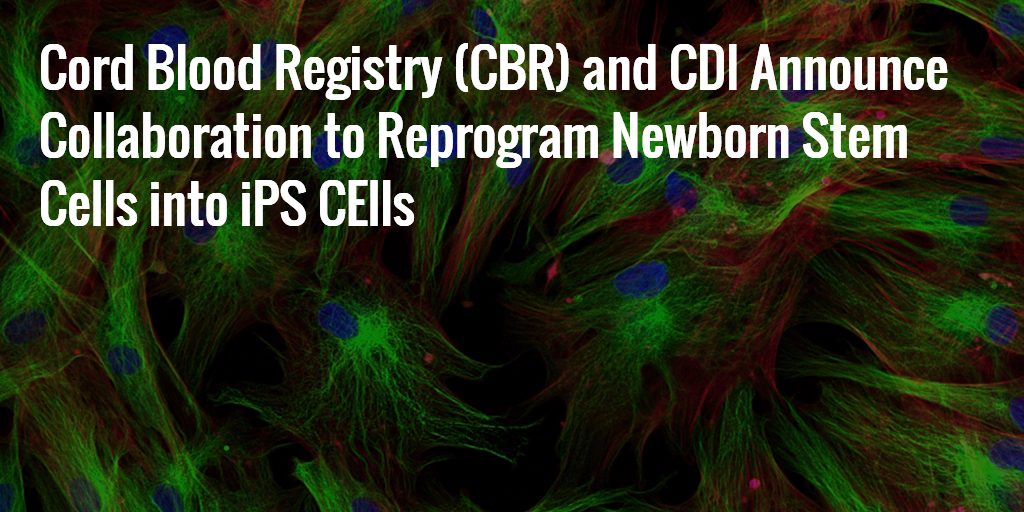It has long been recognized that umbilical cord blood could provide a readily available supply of cells for the creation of induced pluripotent stem cell (iPS cell) populations.
Now, a collaboration has been announced between Cord Blood Registry (CBR), the largest American cord blood bank, and Cellular Dynamics International (CDI), the world’s largest iPS cell company.
Specifically, the research partnership will reprogram umbilical cord blood and tissue-derived stem cells that have been processed and cryopreserved under CBR’s protocols into iPS cells that will be produced using CDI’s proprietary methods.
To learn more, see the full press release below.
Cord Blood Registry and Cellular Dynamics International Announce Collaboration to Reprogram Newborn Stem Cells into Induced Pluripotent Stem Cells
SAN BRUNO, Calif. and MADISON, Wis., Jan. 13, 2015 /PRNewswire/ — Cord Blood Registry® (CBR®)and Cellular Dynamics International (NASDAQ: ICEL) (CDI) announced today that they have entered into a research collaboration to reprogram newborn stem cells from both umbilical cord blood and umbilical cord tissue collected, processed and cryopreserved under CBR’s protocols into induced pluripotent stem cells (iPSCs) using CDI’s proprietary methods.
iPSCs, cells that have the ability to replicate indefinitely and to differentiate into any cell type in the human body, are one of the most promising frontiers in human medicine. Once an iPSC line is created, it becomes a renewable source of starting material for differentiation into any tissue of the body. iPSCs are currently used by researchers in disease modeling, drug screening and in the early stages of cell-based therapy clinical trials. A patient-specific iPSC line would have significant potential in future cell therapies as any tissue differentiated from those iPSCs would be a perfect genetic match to the individual from whose cells the original line was created.
Hematopoietic stem cells (HSCs), like those found in umbilical cord blood, and MSCs, like those found in cord tissue, have previously been shown by researchers to be reprogrammable into iPSCs (Mack, 2011 and Cai, 2010).
However, this research collaboration will be unique in that a leader in iPSC technology and the world’s largest cord blood bank have partnered to establish a workflow to allow HSCs and MSCs collected and cryopreserved at birth by CBR to be later reprogrammed into iPSCs for individuals.
“CBR is excited to enter into this research collaboration with CDI, a leader in iPSC technology,” said Geoffrey Crouse, President and CEO of CBR. “Establishing a repeatable process, by which CBR’s clients can have their newborn stem cells reprogrammed to become induced pluripotent stem cells, has the potential to increase the future utility of the cells we store in our bank. The stem cells our clients have stored are particularly unique as a starting material as they are collected at birth and typically undamaged by age, disease and environmental factors that may be encountered through life.”
“We look forward to applying CDI’s proprietary episomal reprogramming technique to create iPSCs from cells stored in CBR’s bank,” said Bob Palay, Chairman and CEO of CDI. “Our goal is for the families who have entrusted CBR to store newborn stem cells from more than 500,000 children to know that they can have CDI establish a line of individualized iPSCs that matches their own genetic material. Given the rate of clinical advancements in iPSCs and their capacity to differentiate into different tissues, the ability to create a pluripotent stem cell from newborn stem cells has the potential to become a very valuable resource to treat disease.”
About Cord Blood Registry
About Cellular Dynamics, Inc.
Customers use our iCell O/S products, among other purposes, for drug discovery and screening; to test the safety and efficacy of their small molecule and biologic drug candidates; for stem cell banking; and in the research and development of cellular therapeutics. CDI was founded in 2004 by Dr. James Thomson, a pioneer in human pluripotent stem cell research at the University of Wisconsin-Madison. CDI’s facilities are located in Madison, Wisconsin, with a second facility in Novato, California. See www.cellulardynamics.com.
Forward-looking Statements
To the extent that statements contained in this press release are not descriptions of historical facts regarding Cellular Dynamics International, Inc., including statements regarding the reprogramming of iPSCs from newborn stem cells and their potential value for treatment of disease, they are forward-looking statements reflecting the current beliefs and expectations of management made pursuant to the safe harbor provisions of the Private Securities Litigation Reform Act of 1995. Words such as “may,” “will,” “believe,” “expect,” “anticipate,” “estimate,” “intend,” and similar expressions (as well as other words or expressions referencing future events, conditions or circumstances) are intended to identify forward-looking statements. Forward-looking statements in this release involve substantial risks and uncertainties that could cause our product development efforts, actual results, performance or achievements to differ materially from those expressed or implied by the forward-looking statements. Cellular Dynamics undertakes no obligation to update or revise any forward-looking statements. For a further description of the risks and uncertainties that could cause actual results to differ from those expressed in these forward-looking statements, as well as risks relating to the business of the Company in general, see Cellular Dynamics’ Annual Report on Form 10-K/A filed with the Securities and Exchange Commission on March 11, 2014, which risks are incorporated herein by reference, and as may be described from time to time in Cellular Dynamics’ subsequent SEC filings.
References
1. Mack AA, Kroboth S, Rajesh D, Wang WB. Generation of Induced Pluripotent Stem Cells from CD34+ Cells across Blood Drawn from Multiple Donors with Non-Integrating Episomal Vectors. PLoS ONE 2011;6(11): e27956.
2. Cai J, Li W, Su H, et al. Generation of Human Induced Pluripotent Stem Cells from Umbilical Cord Matrix and Amniotic Membrane Mesenchymal Cells. J. Biol Chem. 2010;285(15)11227-11234.
